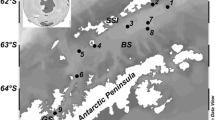Abstract
The bacterial biota associated with the cuticle surface of healthy benthic samples of crustose nonarticulated coralline algae from the east coast of Tasmania (Australia) was examined by bacteriological cultivation and electron microscopy. In 32 samples studied, the viable count on Zobell's marine agar (supplemented with vitamins) was 3.3×106 bacteria g−1 wet wt. (range 2.9×104–2.7×107). Of 732 strains isolated from 16 out of 32 samples and identified to genus level,Moraxella was the predominant genus (66%). In contrast,Moraxella comprised only 11% of 217 strains isolated from benthic seawater samples collected at the same time as coralline algae. In 22 out of 32 algal samples examined by scanning electron microscopy, the total count was 1.6 × 107 bacteria g−1 wet wt. (range 5.1× 106–3.8×107); the major morphotype was cocco-bacilli (80%). Several environmental factors did not significantly influence the viable count or generic distribution, or the total count or morphotypic distribution of bacteria on the cuticle. These factors included geographical site, season, storage of samples in aquarium conditions, and the presence or absence of abalone from shells that the coralline algae encrusted. The microbiota, consisting mostly of the nonmotile bacterial genusMoraxella, appeared to be highly adapted to its calcerous plant host.
Similar content being viewed by others
References
Borowitzka MA, Vesk, M (1978) Ultrastructure of the Corallinaceae. I. The vegetative cells ofCorallina officinalis andC. cuvierii. Mar Biol 46:295–304
Brown C (1973) The effects of some selected bacteria on embryos and larvae of the American Oyster,Crassostrea virginica. J Invertebr Pathol 21:215–223
Clarke GM (1969) Statistics and experimental design. Arnold, London
Ducklow HW, Mitchell R (1979) Bacterial populations and adaptations in the mucus layers of living corals. Limnol Oceanogr 24:715–725
Garland CD, Stark AE, Lee A, Dickson MR (1978) Quantitation of autochthonous bacteria in rat ileum by scanning electron microscopy and transect line analysis. In: Loutit MW, Miles JAR (eds) Microbial Ecology, Springer Verlag, Berlin, pp 240–243
Garland CD, Lee A, Dickson MR (1979) The preservation of surface-associated microorganisms prepared for scanning electron microscopy. J Microsc 116: 227–242
Garland CD, Nash GV, McMeekin TA (1982) The preservation of mucus and surface-associated microorganisms using acrolein vapor fixation. J Microsc 128:307–312
Gibson DM, Hendrie MS, Houston NC, Hobbs G (1977) The identification of some gramnegative heterotrophic aquatic bacteria. In: Skinner FA, Shewan JM (eds) Aquatic microbiology. (The Society for Applied Bacteriology. Symposium Series No. 6). Academic Press, London, pp 135–159
Hendrie MS, Shewan JM (1979) The identification of pseudomonads. In: Skinner FA, Lovelock DW (eds) Identification methods for microbiologists. (The Society for Applied Bacteriology. Technical Series No. 14). Academic Press, London, pp 1–14
Johansen HW (1981) Coralline algae, a first synthesis. CRC Press, Florida, pp 239
Jones AK (1982) The interactions of algae and bacteria. In: Bull AT, Slater JH (eds) Microbial interactions and communities. Vol. 1. Academic Press, London, pp 189–247
Kaneko T, Hauxhurst J, Krichevsky M, Atlas RM (1978) Numerical taxonomic studies of bacteria isolated from Arctic and sub-Arctic marine environments. In: Loutit MW, Miles JAR (eds) Microbial Ecology. Springer Verlag, Berlin, pp 26–30
Krieg NR (ed) (1984) Bergey's manual of systematic bacteriology. Vol. 1, pp 296–302
Lee JV, Gibson DM, Shewan JM (1977) A numerical taxonomic study of somePseudomonas- like marine bacteria. J Gen Microbiol 98:439–451
Lee JV, Hendrie MS, Shewan JM (1979) Identification ofAeromonas, Vibrio and related organisms. In: Skinner FA, Lovelock DW (eds) Identification methods for microbiologists. (The Society for Applied Bacteriology. Technical Series No. 14.) Academic Press, London, pp 151–176
Simidu U, Kaneko E, Taga N (1977) Microbiological studies of Tokyo Bay. Microb Ecol 3: 173–191
Stevenson LH (1978) A case for bacterial dormancy in aquatic systems. Microb Ecol 4: 127–133
Vasconcelos GJ, Lee JS (1972) Microbial flora of Pacific oysters (Crassostrea gigas) subjected to ultraviolet-irradiated seawater. Appl Microbiol 23:11–16
Author information
Authors and Affiliations
Rights and permissions
About this article
Cite this article
Lewis, T.E., Garland, C.D. & McMeekin, T.A. The bacterial biota on crustose (nonarticulated) coralline algae from Tasmanian waters. Microb Ecol 11, 221–230 (1985). https://doi.org/10.1007/BF02010601
Issue Date:
DOI: https://doi.org/10.1007/BF02010601




